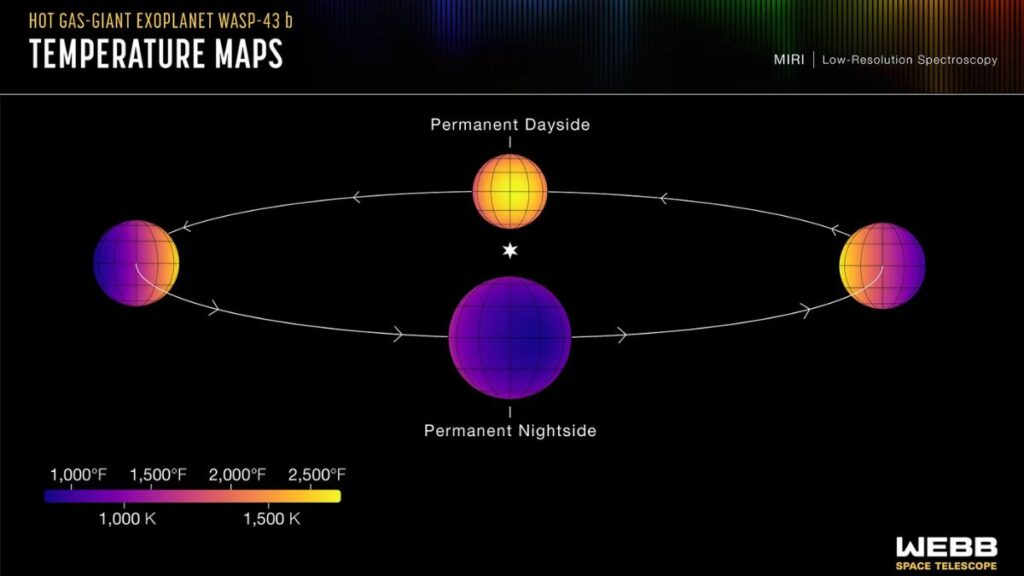A group of scientists used NASA’s James Webb Space Telescope to check the weather on the hot gas giant exoplanet WASP-43b.
WASP-43b is 280 light years away from our Earth orbits a K-type star WASP-43. This star was discovered in 2011 by the Transit method. WASP-43b mass is 1.78 times our Jupiters.
Exact brightness measurements across a wide range of mid-infrared light, in conjunction with 3D climate models and past observations from other telescopes, point to the presence of clear skies during the day, high clouds covering the nightside, and equatorial winds mixing atmospheric gases around the planet at speeds of up to 5,000 miles per hour.
With Webb’s remarkable capacity to monitor temperature fluctuations and detect atmospheric chemicals trillions of kilometers away, the inquiry is only the most recent example of the exoplanet science currently feasible.
WASP-43b is tidally locked with its host star, exoplanet orbits around star WASP-43 at a distance of just 1.3 million miles. WASP-43 is cooler and smaller than our own Sun. Due to less distance between a planet and its star, with a tight orbit, WASP-43b is tidally locked.
Despite being too small, faint, and near its star for direct observation with a telescope, WASP-43 b’s short orbital period of 19.5 hours makes it perfect for phase curve spectroscopy, a method that measures minute variations in the brightness of the star-planet system as the planet orbits the star.
The planet’s temperature may then be determined using the brightness data that Webb collected, as the quantity of mid-infrared light emitted by an object is mostly dependent on its temperature.
Scientists used the James Webb Space Telescope’s MIRI (Mid-Infrared Instrument) to measure light from the WASP-43 system and made primary map of entire planet.
The dayside averages around 2,300 degrees Fahrenheit (1,250 degrees Celsius), which is hot enough to forge iron, according to the readings. With a temperature of 1,100 degrees Fahrenheit (600 degrees Celsius), the nightside is considerably colder.

The information is also useful in determining the planet’s “hotspot,” which is located slightly east of the point in the planet’s sky where the star is highest and gets the greatest amount of stellar radiation. Supersonic winds induce this change by moving warm air eastward.
Is Methane present in the atmosphere of WASP-43b?
The quantity of methane (CH4) and water vapor (H2O) on the planet might also be measured thanks to Webb’s wide range of mid-infrared light capture. Co-author Joanna Barstow of the Open University in the United Kingdom stated, “Webb has given us an opportunity to figure out exactly which molecules we’re seeing and put some limits on the abundances.”
The spectra provide extra information on the thickness and height of the clouds in the atmosphere by clearly displaying water vapour on both the planet’s dayside and nightside.
Remarkably, the data also clearly indicates that there isn’t any methane in the atmosphere at all. Methane should remain stable and observable on the colder nights even if the dayside is too hot for it to exist (the majority of the carbon should be in the form of carbon monoxide).
Barstow said, “We know that WASP-43b must have wind speeds of up to 5,000 miles per hour because we don’t see methane.” It is not possible for measurable levels of methane to be produced on the nightside by the predicted chemical processes if winds are moving gas quickly enough from the dayside to the nightside and back again.
Editor’s Recommendations
- Astronomers Found, Evidence for Mystery Planet 9
- Astronomers Detected 1st Magnetar Flare Outside Our Milky Way
- Antarctica from Space! Look at these Stunning Views of Antarctica







